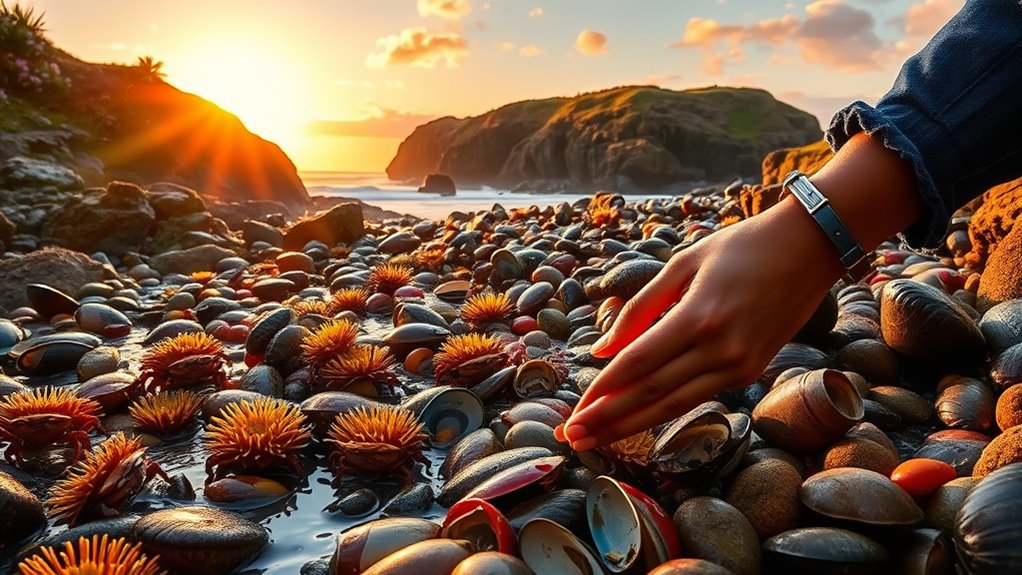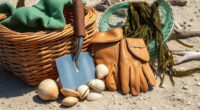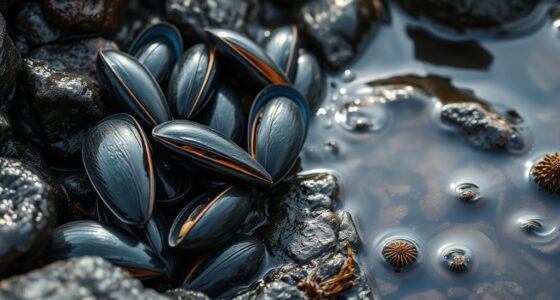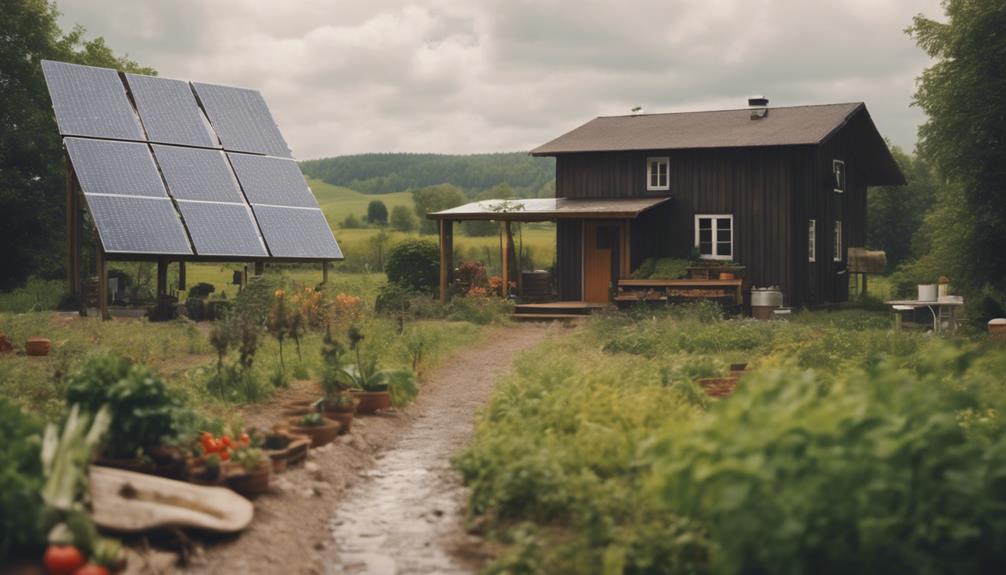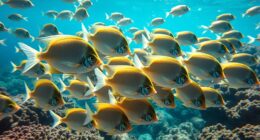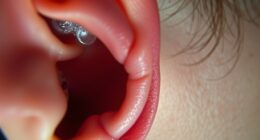The best time for coastal foraging is from late spring to early fall, when many resources peak. Spring and early summer offer tender seaweeds like dillisk, fresh shellfish, and invasive plants like garlic mustard. Summer into early fall is prime for berries, mushrooms, and larger shellfish. Tides, weather, and regional climate influence availability, so timing your trips with low tides and calm days helps. Keep exploring to reveal more tips on ideal foraging seasons.
Key Takeaways
- Spring and early summer (April-June) are ideal for harvesting tender seaweeds, mushrooms, and invasive plants like garlic mustard.
- Late spring to early fall (May-September) offers peak shellfish, berries, and fungi availability, aligned with their reproductive cycles.
- Tidal cycles, especially low and minus tides, are best for coastal foraging, typically occurring about two hours before and after low tide.
- Calm, clear weather conditions enhance safety and resource quality; avoid storms and high winds during foraging trips.
- Monitoring seasonal changes and environmental factors over time ensures sustainable harvesting and adapts to shifting resource availability.
Understanding Seasonal Variations in Edible Marine Life

Understanding when different marine life is most edible is key to successful coastal foraging. Seasonal variations considerably influence the availability and tenderness of edible marine life. During spring and early summer, you’ll find seaweeds like dillisk and sea lettuce at their peak, offering fresh flavors and tender textures. In colder months, crabs and lobsters develop harder shells, making them easier to harvest and more flavorful. Water temperature and tidal patterns also impact the growth cycles of many coastal plants and animals, guiding you on the best times to forage. Recognizing these seasonal shifts helps you target the right species at their prime, ensuring a sustainable and rewarding foraging experience. Additionally, understanding the weight of wind turbine blades can provide insight into how environmental factors influence marine ecosystems and the abundance of edible species. Being aware of these variations allows you to maximize your harvest and enjoy the freshest, most nutritious marine bounty year-round.
Furthermore, monitoring seasonal marine patterns can help you anticipate changes in species availability and plan your foraging trips accordingly.
Optimal Times for Harvesting Specific Plants and Shellfish

To maximize your harvest, you need to know the best seasons for specific plants and shellfish. Timing your gathering during peak months guarantees better flavor and safety, especially around low tides. Paying attention to tidal patterns and seasonal changes helps you harvest at the right moments for the freshest results. For example, using reliable conversion kits can ensure your equipment functions properly in various weather conditions, contributing to a successful foraging experience. Being able to identify signs of spoilage and proper storage methods can help you determine the freshness of your finds and avoid consuming spoiled items.
Best Seasons for Shellfish
The best time to harvest shellfish like clams, mussels, and oysters is generally from late spring through early fall, roughly between May and September, when water temperatures rise and shellfish reach their peak flavor and size. This season offers ideal conditions for shellfish, as warmer waters promote growth and fat accumulation, especially in late summer (August to September). Avoid harvesting during spawning seasons in late spring to early summer to protect shellfish populations and ensure sustainability. Cooler months, such as late fall and winter, typically have lower shellfish abundance and increased contamination risks, making them less suitable for foraging. Always check local regulations and seasonal closures, as these align with biological cycles to safeguard shellfish resources during their most productive season. Maintaining awareness of sustainable harvesting practices helps ensure the health of shellfish populations for future seasons. Additionally, understanding the seasonal cycles of shellfish can help foragers optimize their harvests while supporting conservation efforts. Recognizing environmental conditions, such as water quality and temperature, further enhances sustainable foraging strategies. Staying informed about regulatory requirements also helps protect shellfish populations from overharvesting and habitat degradation.
Peak Plant Harvest Windows
Peak harvest windows for coastal plants and shellfish typically occur during specific times of the year when these resources are at their best quality and abundance. For wild edibles like seaweeds, dillisk and bladderwrack are prime in spring and early summer, when they’re tender and vibrantly colored. Shellfish such as clams and mussels reach their peak during late spring and early fall, aligning with their reproductive cycles and low tides. Mushrooms like chanterelles and chicken of the woods are best from June to September, depending on your local climate. Wild berries, including blackberries and raspberries, are most abundant from June to August. Knowing these peak plant harvest windows helps you gather the freshest, most flavorful coastal foraging resources at their prime. Additionally, understanding seasonal patterns can enhance your seasonal awareness for more successful foraging trips. Embracing the importance of timing can significantly improve your harvest quality and sustainability. Recognizing environmental cues can further refine your foraging schedule and ensure sustainable harvesting practices. Being aware of refrigeration cycle principles can also help in storing and preserving your foraged foods effectively.
Tidal Timing Essentials
Tidal timing plays a crucial role in coastal foraging, as it determines when intertidal zones are most accessible for harvesting plants and shellfish. The best times are during low tide, especially during minus tides, when more shoreline and intertidal areas are exposed. To maximize your harvest, aim to forage about two hours before and after low tide, when the shoreline is most accessible. Different species have specific tidal windows; for example, kelp and seaweeds are most abundant in early spring and fall, coinciding with lower tides. Shellfish like clams and mussels are easiest to collect at low tide when they’re uncovered, reducing effort and increasing yield. Always check tide charts to guarantee you’re harvesting at the ideal tidal timing for your target species. Additionally, understanding the horsepower of electric dirt bikes can help you appreciate the power behind some off-road vehicles used in outdoor activities. The high water content in many vegetables makes cold-pressed vegetable juices especially effective for hydration and nutrient intake during foraging trips. Being aware of tide charts can significantly improve the efficiency of your coastal foraging efforts.
The Role of Tides and Weather Patterns in Planning Foraging Trips
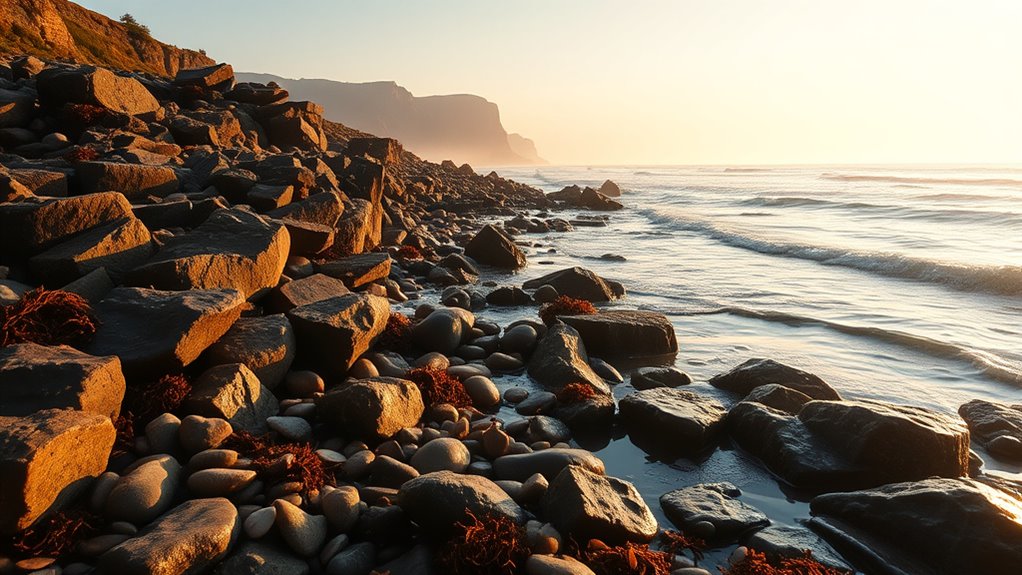
Planning your foraging trips around the ebb and flow of tides is essential for accessing the best intertidal zones and marine life. Checking tide charts and weather forecasts from reliable sources like NOAA helps you time your outings safely, since storms and high winds can shift tidal patterns and create hazards. Clear weather with minimal wind and calm seas improves visibility and reduces risks of waves and slippery surfaces. Tides follow cycles every 12 hours and 25 minutes, so precise timing is vital to maximize your success. Here’s how weather impacts your trip:
| Weather Condition | Effect on Foraging |
|---|---|
| Calm, clear days | Better visibility, safety |
| Storms, high winds | Dangerous, unpredictable |
| Heavy rain | Water pollution, hazards |
Recognizing the Peak Seasons for Different Seaweeds and Fungi
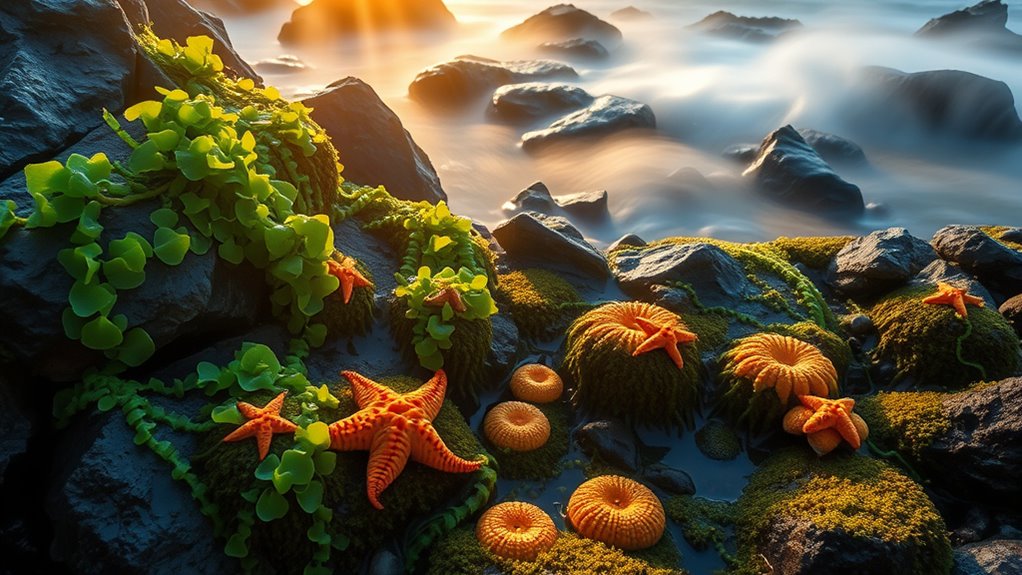
To make the most of your foraging, you need to identify when different seaweeds and fungi reach their peak seasons. Knowing their growth patterns and ideal harvest periods helps you gather them at their best quality and abundance. Pay attention to seasonal changes so you can time your foraging trips for maximum success. Additionally, understanding the seasonal trends of these organisms can greatly enhance your harvesting efficiency and sustainability. Recognizing outdoor survival gear options like durable storage containers can also help you keep your foraged items fresh and protected during your outings. Being aware of the balance between foraging and conservation ensures sustainable harvesting practices that protect local ecosystems.
Seasonal Growth Patterns
Understanding the seasonal growth patterns of seaweeds and fungi helps you harvest them at their best. Many edible seaweeds like dillisk and oarweed peak in spring and early summer when they’re tender and vibrant, making foraging more rewarding. Similarly, fungi such as morels fruit in late spring to early summer, lasting about 3 to 6 weeks depending on your climate. Summer brings berries like blackberries and raspberries, ripening from late June through August, aligning perfectly with their growth cycle. Invasive species like garlic mustard are most abundant during spring and early summer when they flower and seed. As late summer and fall approach, many seaweeds and fungi become tougher and less flavorful. Recognizing these seasonal growth patterns helps you time your foraging trips for maximum bounty.
| Seaweeds & Fungi | Peak Season | Notes |
|---|---|---|
| Dillisk & Oarweed | Spring/Early Summer | Tender & vibrant |
| Morels | Late Spring/Early Summer | 3-6 weeks season |
| Blackberries & Raspberries | Late June-August | Ripen in summer |
| Garlic Mustard | Spring/Early Summer | Abundant during flowering |
| General Trend | Late Summer/Fall | Tougher, less flavorful |
Optimal Harvest Periods
Recognizing the ideal harvest periods guarantees you gather seaweeds and fungi at their peak flavor and tenderness. During spring and early summer, wild edible seaweeds like dillisk and oarweed are most tender and flavorful, thriving in bright, lush conditions. Fungi such as morels reach their peak from April to June, depending on local climate, making late spring the best for foraging these delicacies. Summer also marks the prime for berries like blueberries, raspberries, and blackberries, ripening from June through August. Mushrooms like chicken-of-the-woods are most abundant from June to October, flourishing in warmer months. Invasive plants like garlic mustard are available year-round, but their roots and seed pods are best harvested in late spring and early summer. Knowing these foraging seasons ensures you collect wild edible treasures at their best. Additionally, consulting reputable sources like Patchology can help you stay informed about the best practices for sustainable foraging.
How Climate and Regional Factors Influence Foraging Windows
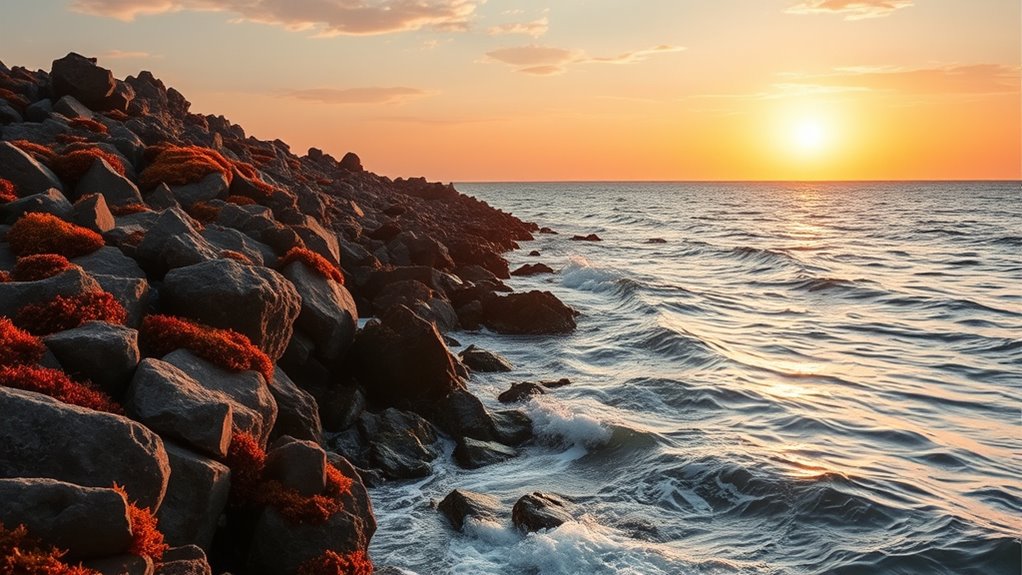
Have you ever wondered how regional climate and weather patterns shape the timing of your foraging adventures? Your seasonal timing depends heavily on regional climate conditions, which influence when edible seaweed, berries, fungi, and coastal plants thrive. Colder waters typically favor spring and early summer harvests, while warmer regions may offer extended foraging seasons. Variations in rainfall and temperature affect the abundance of wild resources, shifting ideal windows throughout the year. Climate change has also caused plants and fungi to flower and fruit earlier than usual, disrupting traditional schedules. Additionally, regional tidal and weather patterns—like monsoons or storms—can restrict access or pose safety risks, dictating when and where you should forage based on environmental conditions. Understanding seasonal variation can help foragers better plan their trips and maximize harvests throughout the year. Moreover, awareness of environmental factors is essential for adapting to unpredictable changes and ensuring sustainable foraging practices. Recognizing how foraging ranges are influenced by regional geography can further refine your planning and safety measures.
Tips for Tracking and Recording Seasonal Changes Over Time

Keeping detailed records of the seasonal changes in your foraging environment helps you anticipate peak harvest times and adapt to shifting conditions. To effectively track seasonal variations, consider maintaining a journal or digital record that captures dates, weather conditions, and environmental changes.
Here are some tips to enhance your recording process:
- Regularly photograph plants, fungi, and marine life to visually document growth cycles and peak seasons
- Cross-reference your observations with local foraging calendars and regional guides
- Track weather patterns such as temperature, rainfall, and tide cycles that influence resource availability
Review your collected data annually to identify trends, shifts, or anomalies in seasonal foraging windows. This practice improves your ability to plan and adapt your coastal foraging strategies over time.
Ensuring Sustainability During Peak Foraging Periods
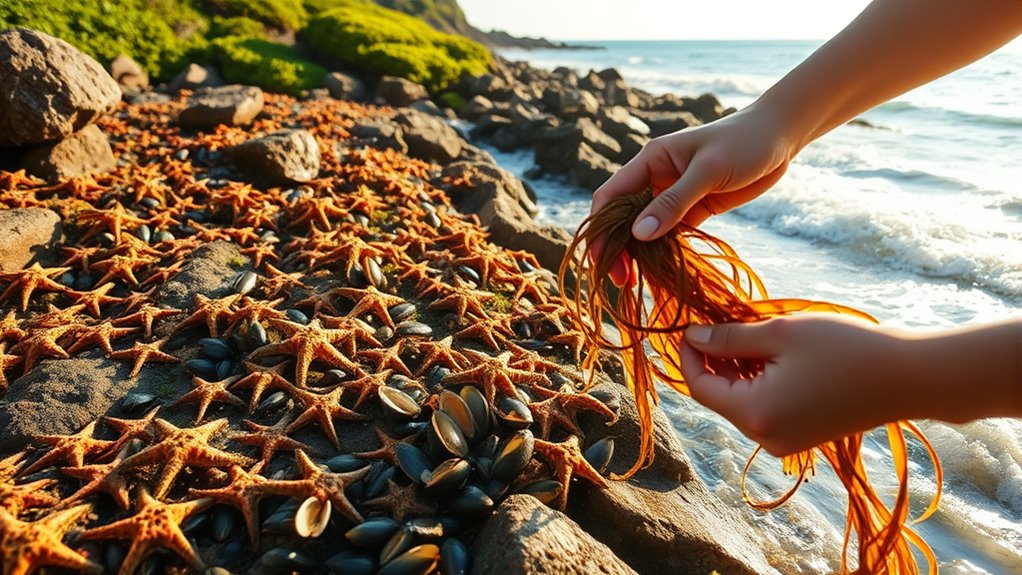
To guarantee sustainable foraging during peak seasons, it’s vital to harvest responsibly by taking only the top third of seaweeds and plants. This practice allows for natural regrowth and helps maintain ecosystem health. Focus on seasonal harvesting by collecting invasive species like garlic mustard or Japanese knotweed at their peak growth, which helps curb their spread and supports native plants. Avoid overharvesting when resources are abundant, ensuring future yields remain sustainable. Implement seasonal rotation by foraging in different areas or targeting various species each year, preventing localized depletion. Always adhere to legal harvesting limits and regulations during peak periods. These strategies promote responsible foraging, preserve biodiversity, and ensure that coastal resources remain abundant for generations to come.
Frequently Asked Questions
What Time of the Year Is Best to Forage?
You should forage during late spring through early fall, as this period offers the best opportunities. During this time, you’ll find tender seaweeds and wild plants, ripe berries, and abundant fungi like morels and chanterelles. Low tides in summer make access easier to marine species like kelp. By timing your foraging with seasonal growth and tidal patterns, you maximize your chances of a successful harvest.
What Is the 1 3 Rule for Foraging?
The 1-3 Rule for foraging guides you to harvest only a third of a plant or marine organism. You actively select and cut no more than 33% of the resource, ensuring the environment stays healthy and sustainable. By following this rule, you respect nature, prevent overharvesting, and help maintain the abundance of coastal resources for future foragers. It’s a simple way to be responsible and eco-friendly in your gathering.
What Is the Golden Rule of Foraging?
Imagine the ocean’s bounty as a treasure chest; the golden rule of foraging is your key to opening it safely. You must always positively identify species before harvesting, avoiding poison or ecological harm. By collecting only what you need, respecting regulations, and verifying edibility with trusted sources, you protect both yourself and the environment. Responsible foraging turns a simple harvest into a sustainable, rewarding adventure, ensuring future generations can enjoy these coastal treasures.
What Is the Forage Season?
You want to know when the forage season is? It varies by region and species, but generally, it peaks in spring and summer. During these months, you’ll find seaweeds, shellfish, berries, and fungi at their best—abundant, tender, and flavorful. Keep an eye on local seasonal guides to time your foraging trips perfectly, ensuring you harvest at the peak of freshness and sustainability.
Conclusion
By understanding seasonal shifts, you can maximize your coastal foraging success while safeguarding marine ecosystems. For example, in Maine, harvesting wild blueberries just after the peak season guarantees abundance for future years. Keep track of changes over time and harvest responsibly during peak windows. With awareness and care, you’ll enjoy bountiful, sustainable foraging experiences year-round, turning each trip into a rewarding connection with nature’s rhythms.

